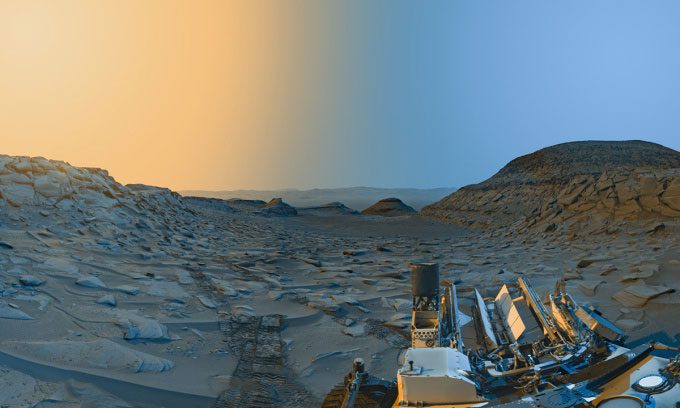NASA’s Curiosity Rover Captures Stunning Martian Landscapes, Showcasing Sunlight Variations Between Morning and Evening.
The Curiosity rover recorded remarkable images on April 8, or Sol 3,794 (the 3,794th day on Mars during Curiosity’s mission), just before departing from the Marker Band Valley, where it discovered signs of an ancient lake in 2022.

The newly released photo from the Curiosity rover is a combination of two images taken at different times on April 8. (Photo: NASA/JPL-Caltech).
This is one of the first tasks Curiosity completed after its “hibernation” for software updates from April 3 to April 7, Live Science reported on June 17. This update included 180 enhancements, the most significant of which allows the rover to process surrounding images faster and reduces wear on its tires, enabling it to move more quickly on Mars.
The new panoramic image is synthesized from two photos, one taken in the morning and the other in the evening. A NASA representative stated that combining sunlight from two different angles results in a much higher detail image compared to a standard photo. The original images were actually black and white, but experts added color to highlight rock formations and simulate the sky’s colors during morning and evening.
This is the second time Curiosity has captured images in this manner. The rover previously took a similar time-split image in November 2021. However, the latest image is much more detailed than the initial attempt. This is likely due to the fact that the photo was taken during Mars’ winter, when there was less atmospheric dust, according to Doug Ellison, an engineer at NASA’s Jet Propulsion Laboratory (JPL), who leads Curiosity’s camera team. The rover rarely captures such images because it needs to remain in one spot throughout the day, limiting the amount of data it can collect.
In addition to vast landscape photos, Curiosity has also turned its camera downward to capture close-up images of unique mineral structures. For instance, in February 2022, the rover observed a mineral structure resembling a flower. On April 15 of this year, it also discovered a small rock shaped like a book.




















































